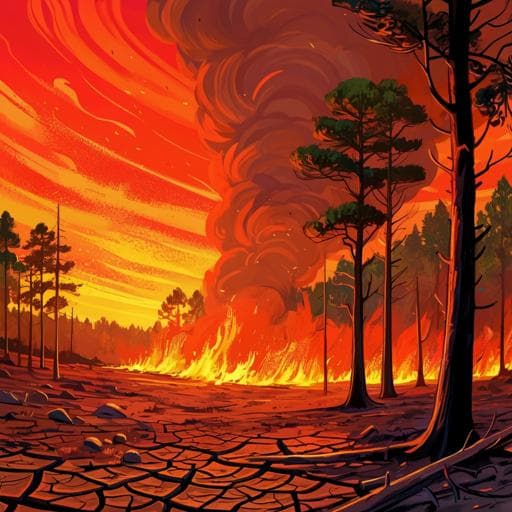
Earth Sciences
Human-ignited fires result in more extreme fire behavior and ecosystem impacts
S. Hantson, N. Andela, et al.
Discover how recent research by Stijn Hantson, Niels Andela, Michael L. Goulden, and James T. Randerson reveals the alarming trends of human-ignited wildfires in California. Their study highlights the urgent need to limit these fires during extreme weather to protect our forests and mitigate tree mortality rates, which are over three times higher for rapidly spreading fires. Tune in to understand the critical insights behind these explosive wildfire patterns!
~3 min • Beginner • English
Introduction
The study addresses how ignition source (human vs. lightning) interacts with meteorology and ecosystem status to shape wildfire behavior and impacts in California. While prior work has focused on increases in burned area linked to climate change, fuel build-up from historical suppression, and expanded human presence in the wildland–urban interface, there has been less emphasis on fire behavior and consequent ecosystem effects. California’s burned area has more than doubled in recent decades, yet historical (Holocene) fire regimes suggest that present-day area burned may still be below long-term levels, with past fires typically of lower severity. The authors hypothesize that human ignitions more frequently coincide with extreme fire weather, producing faster initial spread and higher severity than lightning-caused fires. They pose four questions: (1) Do human-caused fires occur under different environmental conditions than lightning-caused fires? (2) Do these differences lead to differing fire behavior? (3) Does rate-of-spread influence fire severity? (4) Do human-caused fires have different ecosystem impacts than lightning-caused fires?
Literature Review
The paper situates its work within research showing increased wildfire activity due to climate warming (elevated temperatures, higher vapor pressure deficit, longer fire seasons) and the effects of 20th-century suppression leading to fuel accumulation. Studies have linked burned area increases to climate and fuel changes, but have largely neglected fire behavior metrics beyond area burned due to data limitations. Human expansion into the WUI has increased ignition frequency and broadened the environmental niche for fires. Historical California fires were frequent but generally lower severity. The paper notes limited quantitative information over large areas on how fire behavior affects severity and tree mortality, highlighting the need for datasets that link meteorology, fuels, and behavior to ecosystem impacts.
Methodology
Data and scope: The authors compiled a daily fire spread (rate-of-spread, ROS) dataset for California wildfires recorded in the FRAP database from 2012–2018, including fires larger than 300 ha and burning for 2 or more days. Ignition causes were categorized as human, lightning, or unknown (unknown excluded from cause-based comparisons). The dataset includes 214 fires, 2939 fire days, and 21,558 km² burned area across Northern California and Mediterranean California ecoregions.
Active fire detections and perimeter reconstruction: They used VIIRS 375 m I-band active fire detections (Suomi-NPP) within a 750 m buffer around FRAP perimeters between ignition and containment (with a 1-day temporal buffer, or 3-month window when dates were missing). Daily growth was estimated by grouping detections from the daytime overpass (~1:30 p.m.) and the following nighttime overpass (~1:30 a.m. next day), using the last overpass time when swaths overlapped. Daily end-of-day perimeters were constructed by applying the alpha-hull algorithm (R package alphahull) to the centers of active fire pixels. An alpha value of 0.05 was used (increased by 0.05 increments if needed for continuity). Lightning events with multiple ignitions were separated into distinct groups when the minimum inter-group distance exceeded 1500 m; merged when fires coalesced.
Rate-of-spread estimation: For each day (except day 1, due to unknown exact ignition position/time), they identified active fire line points (including detections up to 100 m behind the estimated perimeter), computed minimum distances to the previous day’s perimeter, divided by elapsed time to calculate spread rates, and summarized daily ROS as the 95th percentile across fire line points (also compared to mean ROS; highly correlated). Days with zero advance yielded ROS of zero. Daily ROS distribution was analyzed both per fire day and weighted by burned area.
Environmental drivers: Environmental conditions on ignition days were characterized using gridMET daily climate (e.g., energy release component, potential evapotranspiration, windspeed) at 4 km resolution and vegetation/biomass from LEMMA at 30 m. Forest cover and biomass metrics were included.
Fire severity and ecosystem impact: Fire severity was quantified via MTBS-derived differenced normalized burn ratio (dNBR) and relative differenced NBR (rdNBR), and a US Forest Service tree mortality product (percent reduction in tree basal area). For each fire day, severity metrics were sampled for the newly burned area (30 m pixels) and summarized by mean and 95th percentile to examine relationships with daily ROS. Severity was also summarized at the fire level to compare human vs. lightning ignitions, stratified by Northern and Mediterranean California ecoregions, and by forest vs. non-forest using CALVEG 2011.
Statistical analyses: Differences in mean fire number, size, and ROS between ignition types were tested with Welch Two-Sample t-tests (variables with heavy tails log-transformed). Differences in distributions of daily ROS were tested with two-sample Kolmogorov–Smirnov tests. Variability summarized using interquartile range. Burned-area-normalized mean ROS was computed as the sum over days of (burned area × ROS) divided by total burned area. Analyses were repeated within ecoregions, seasons (summer/fall), and biomass strata (>150 Mg ha−1) to test robustness.
Key Findings
- Initial growth differences: Human-caused fires were on average 6.5× larger at the end of day 1 than lightning-caused fires (18.8 vs. 2.9 km²; Welch t=6.51, p=8.27e−10). After 5 days, human-caused fires remained more than 3× larger on average (115.1 vs. 37.5 km²; t=4.93, p=3.09e−6). Differences persisted across ecoregions (Northern, Mediterranean) and seasons, and even within high-biomass forests (>150 Mg ha−1).
- Rate-of-spread (ROS): Daily ROS distributions were highly skewed, with many slow days (<0.5 km d−1) and rare fast days (>5 km d−1). Human-caused fires spread faster on average than lightning-caused fires (mean daily ROS 1.83 vs. 0.84 km d−1; KS D=0.35036, p<2.2e−16). When weighted by burned area, mean ROS increased to 5.6 km d−1 (human) and 3.5 km d−1 (lightning), with distributions still significantly different (KS D=0.19921, p<2.2e−16).
- Duration and final size: Despite higher ROS early, human-caused fires had somewhat larger final sizes only (113 vs. 84 km²) because they reached 75% of their final size more quickly: 50% of human-caused fires did so within ≤3 days vs. ≤10 days for lightning-caused fires, indicating shorter spread duration for human fires.
- Ignition conditions: Human-caused fires ignited under more extreme fire weather and in lighter fuels than lightning-caused fires (mean on ignition day): energy release component 67.6 vs. 64.4 (p=1.3e−4); potential evapotranspiration 8.6 vs. 7.6 mm d−1 (p=3.7e−16); windspeed 3.3 vs. 2.6 m s−1 (p<2.2e−16). Human ignitions were in areas with lower forest biomass (39 vs. 131 Mg ha−1) and forest cover (25% vs. 63%) (both p<2.2e−16).
- Fire impact linkage: Faster-moving fires produced higher tree mortality. Slow fires (mean daily ROS <0.5 km d−1) had mean tree mortality 15.3 ± 18.0%, whereas fast fires (>2 km d−1) had 48.3 ± 19.7%. This relationship held for both ignition sources and for other severity metrics (dNBR, rdNBR).
- Severity by ignition type and ecoregion: In Northern California, human-caused fires exhibited higher maximum and mean severity (dNBR, rdNBR) and higher mean tree mortality (44.4% vs. 35.2%; significant). In Mediterranean California, maximum dNBR/rdNBR tended to be higher for human-caused fires, but mean tree mortality was higher for lightning-caused fires (63% human vs. 78% lightning; significance varies by metric).
- Extremes dominate: The top 10% fastest fire days accounted for 55% of total burned area, implying that reducing ignitions during extreme weather could substantially lower statewide fire-induced tree mortality.
Discussion
The findings confirm that ignition source structures the causal chain from meteorology and fuels to fire behavior and ecosystem impacts. Human ignitions occur more often during extreme fire weather and in lighter, faster-drying fuels (grass/shrub), producing rapid initial spread and higher intensity, which translate to increased burn severity and tree mortality. Lightning ignitions typically coincide with more moderate, often humid conditions and can be located in remote, high-biomass forests, leading to slower initial spread but potentially longer durations due to accessibility and management policies. The strongly skewed distribution of daily ROS highlights the outsized role of rare, extreme spread days, which many models underrepresent. Observed increases in fire radiative power for fast-moving fires suggest higher energy release rates as a mechanistic link to elevated mortality. Management implications include focusing on limiting human ignitions during extreme weather, considering fuel treatments around high-ignition-probability areas, and recognizing ecosystem-specific strategies between Northern and Mediterranean California. The results also support the potential benefits of allowing some lightning-caused fires to burn under suitable conditions, given their generally lower initial intensity and severity relative to human-caused fires.
Conclusion
This study introduces a standardized, satellite-informed dataset of daily wildfire rate-of-spread for California, enabling direct linkage of ignition conditions, fire behavior, and ecosystem impacts. Human-caused fires are shown to ignite under more extreme weather, spread faster in their initial days, and produce higher severity and tree mortality than lightning-caused fires, particularly in Northern California forests. The dominance of extreme spread days in contributing to burned area underscores the effectiveness of targeting human ignition reduction during extreme fire weather as a mitigation strategy. Future work should quantify differences in suppression resource allocation between ignition types, refine fuel treatment strategies around high-risk ignition zones, and improve fire behavior and severity representation in ecosystem and risk models to capture the non-linear, skewed nature of spread rates.
Limitations
- Scope restriction: Analyses include only large, multiday fires (>300 ha, ≥2 burning days), which represent 88% of burned area but a small fraction of total fire count; unknown-cause fires were excluded from ignition-source comparisons.
- Remote sensing constraints: VIIRS active fire detections and alpha-hull reconstructions approximate daily perimeters and may miss fine-scale perimeter complexity; spread on the first day could not be estimated due to unknown ignition time/location.
- Severity data availability: Some fires or portions were not covered by MTBS or the tree mortality dataset and were excluded from those analyses; significance testing for certain ecoregion-metric combinations was limited by sample size.
- Causal attribution: While meteorology and fuels at ignition correlate with faster spread and higher severity, the study does not disentangle the effects of suppression strategies or resource allocation differences between human- and lightning-caused fires; this is identified as an area for future research.
- Generalizability: Results are specific to California’s Northern and Mediterranean ecoregions during 2012–2018 and may not directly transfer to other regions or time periods without accounting for differing fuels, climate, and management contexts.
Related Publications
Explore these studies to deepen your understanding of the subject.







